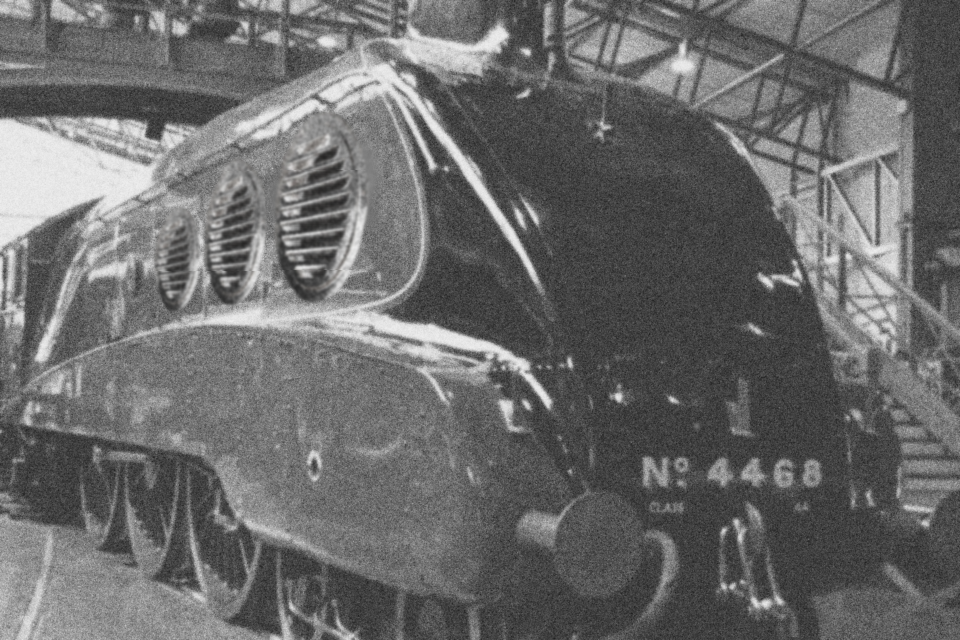Storm Locomotive
The Storm Locomotive is a form of high-speed transportation utilized for both passengers and goods across the continent. The engine is powered by the captured essence of storm elementals, which charges the engine to push the drive wheels along rail tracks.
Appearance
The standard for many passenger locomotives is to be shaped in such a way to provide reduced air resistance. They possess curved, smooth surfaces with almost hidden cabs for the crew, along with sunken lights with rounded glass covers. Because they are powered by electricity captured from storm essence, the locomotives do not possess any means to release steam through funnels or exterior drive pistons, which help lower air resistance. These locomotives are can reach a maximum speed of 100-125 mph. Mixed and goods locomotives do not possess the same streamlined appearance, instead having a boxier, squarer appearance with larger drive wheels and exposed bogies. Their buffers are square and possess large exposed light systems to help drive at night. Their cabs are also not as hidden by the main-battery of the engine, allowing a far better view for the engine's crew. These locomotives cannot reach the same speeds as their streamlined counterparts, struggling to reach and maintain 70 to 100 mph. These engines come in many shapes and sizes depending on the country. As well, these engines can sport different colors and liveries, both based on their rail company and purpose. Goods trains tend to use darker, dirtier colors like reds, browns, and blacks while Passengers tend to be brighter colors like blues, whites, and golds.Purposes
The main distinctions is whether or not the locomotive has a tender. Engines without tenders, often called battery engines, are utilized on short, local services or shunting freight wagons or passenger coaches. Battery engines possess the advantage of being able to pull both goods and passenger services with relative ease. Often, these smaller locomotives are used in larger stations to prepare wagons or coaches and bring them to locomotives for their respective service. These engines are called "station pilots." Tender engines possess the advantage of larger size and the battery tender which allows for longer journeys. They also possess a stronger system, which gives them more power to pull larger and heavier trains. Because of this, these locomotives are used for services spanning one or several countries. These trains also go further than their smaller counterparts without recharging, while also reaching a much higher speed.Propulsion
Utilizing interior equipment, the locomotive use the captured storm elemental essence and converts the electrical energy into mechanical energy. This then powers the motors that drive the axles, allowing the train to move. The engineer then utilizes the throttle to control the speed of the locomotive and keeps watch from their position on the footplate. A secondary person, called a regulator, keeps track of the voltage and volatility of the essence. In case of emergency overcharge or "surges", the regulator can attempt to cool the battery with coolant or discharge the electricity into the tracks using a grounding system through the wheels. This is dangerous, however, as it can leave a train unpowered and stranded.
On larger tendered locomotives, storm essence is stored and the tender acts as a form of portable charging station and is utilized while the train is in motion. However, on smaller locomotives and battery locomotives, power is gained by using the locomotives' interior lightning rods which emerge from the sides and capture essence from Arc Towers.
Nickname
"Rolling Thunder"
"Jarred Lightning"
"Stormies"
"Iron Stormclouds"
"Jarred Lightning"
"Stormies"
"Iron Stormclouds"
Manufacturer
Speed
100-125 mph
Complement / Crew
One Engineer
One Regulator
One Regulator
Liveries are important to many who work the railways of the continent. As it distinctualizes each company. Liveries are the color schemes, designs, and even coats of arms present on each locomotive and often come in three sets. Passenger colors, Freight or Goods colors, and Mixed colors. However, many companies only utilize two, giving a Goods livery to their Mixed traffic engines on smaller railways.
Nothing is more important to an engine than its crew. Because of this, all crews are often dressed in the uniform of their respective employer, whether it be a state-run or private enterprise. For the most part, this is simply some variant of a dress shirt, tie, and jumpsuit with a company logo.
Crews play a vital role in their engine process, but long journeys can be taxing on them. It is required that crew not work over their shifts and, as such, must swap with a new crews at stations if they begin to exceed this time. While the length of time varies from country to country, the time allotted is roughly 12 continuous hours.




Comments